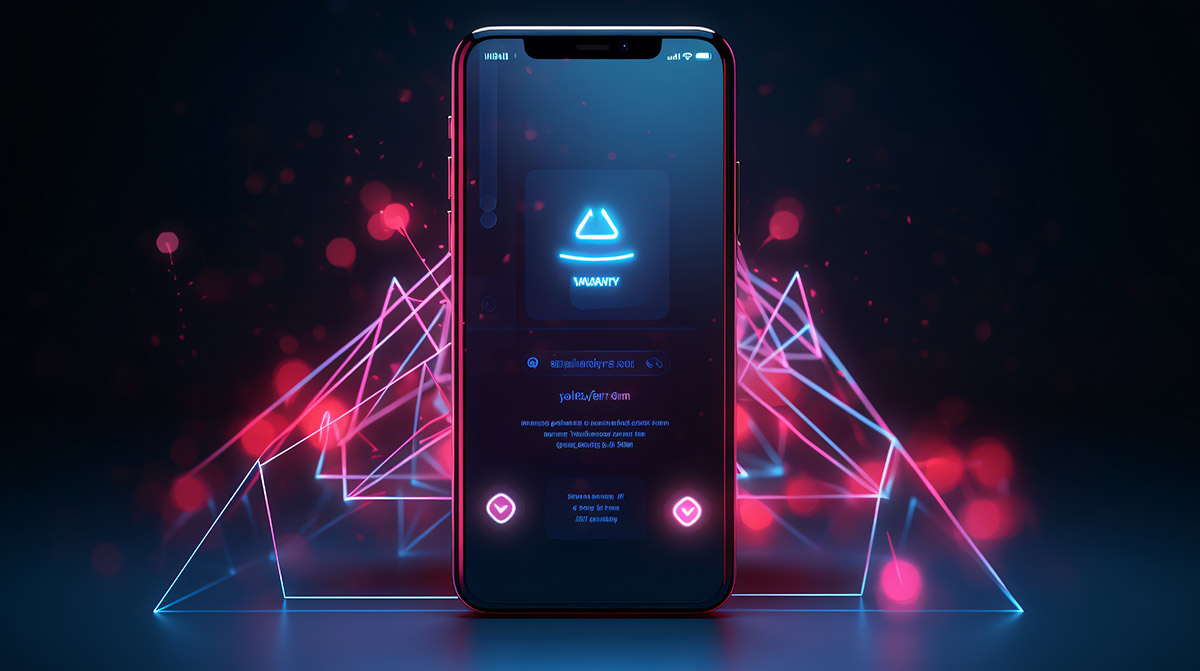
It’s important to develop a strong foundation, especially in mobile app development. As time goes on, businesses focus on creating apps that effectively target their targeted audience. The competitions are fierce.
Statista says more than 2.1 billion apps are available on the Google Playstore compared to 1.8 billion available on the Apple App Store.
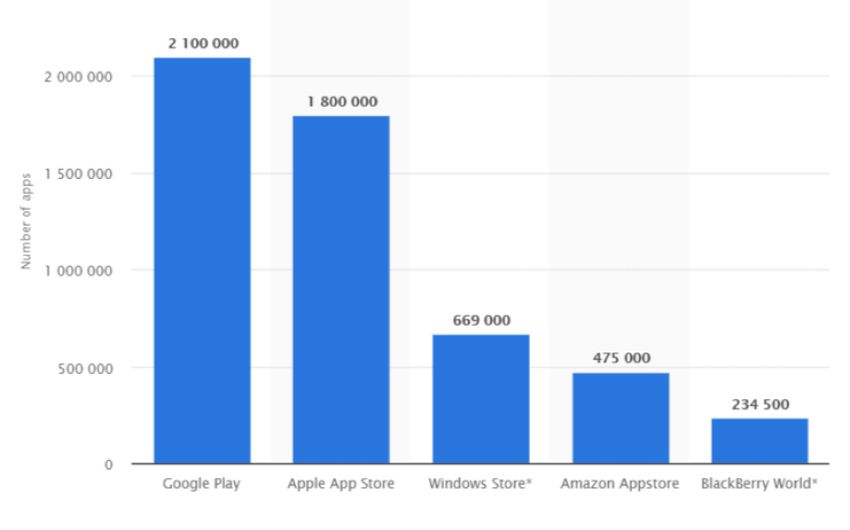
Mobile apps are growing as a whole. Global mobile app revenue is forecasted to hit $935 billion by 2023.
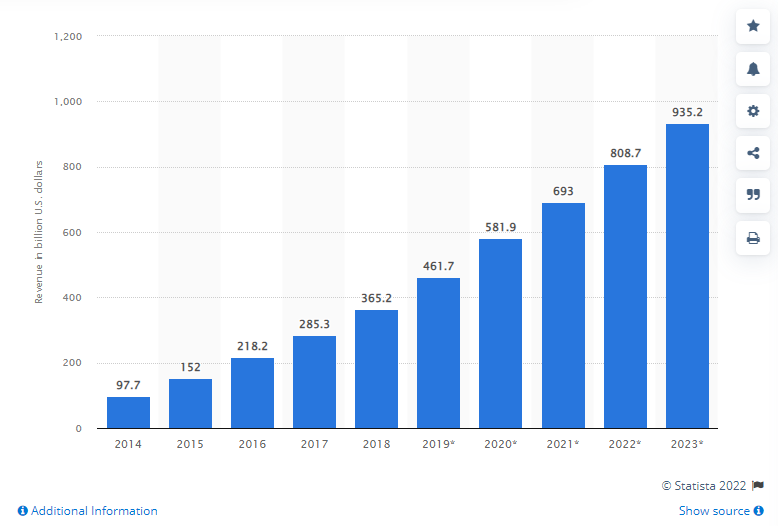
It seems like competitors are tough and don’t permit each other to reach their targets. Therefore, for success in these fought areas, it is essential to pick the best mobile apps available.
What is Mobile App Architecture?
It’s basically an approach for defining structured app ecosystems. Its structure and its respective interfaces are combined and used in building integrated systems and their structural behavior. This can also mean skeletons for apps that determine how the product’s working and quality are derived. Everything that defines an app, such as how the data will be transferred.
How To Design A Mobile App Architecture In 2022?
Development of mobile app architecture involves an incredibly detailed process before development can start. The following guide outlines recommendations that must be followed throughout development to produce a well-designed program easily accessible. Mobility is becoming an epochal requirement. From booking a flight or film tickets to shopping from your sofa or ordering your favorite food from a restaurant or learning new things to paying your bill, the smartphone has an amazing impact on everyone.
What Makes A Good Mobile App Architecture?
The most robust mobile application architecture provides component responsibility layers. Or ideally, a well-architected app should have assumptions or good programming patterns such as SOLID or KISS.
The above requirements allow for rapid development and easy maintenance for your business.
This will save you time.
However, intelligently selected architecture and platform-specific technologies will be the best for solving complex business problems in the best manner for smartphones. Furthermore, this will help you prevent issues that cause the peculiarities of a hybrid device.
Exploring The Elements To Consider When Developing Mobile App Architecture Design
Device Determination
Initially, this requires taking into consideration device size. Screen size is determined using computer specifications, memory, storage, and availability. Therefore, it’s important to understand the devices required for running a mobile application to work with the app.
Bandwidth Status
It will face numerous situations where internet connectivity will dwindle, or it will not even exist at some point. Your software architecture diagram must contain the worst network conditions. The data access system must be designed in the worst-case scenarios.
Right User Interface
In applications, user interfaces are essential. But they are largely overlooked. Having your mobile apps a good interface will determine whether it effectively retains users and gives them a seamless experience.
Real-Time Updates vs. Push Notifications
As an Architect, you need to decide whether users require real-time updates and push notifications. Realtime updates may sound attractive but may be costly. In addition, it could drain a phone’s battery and data. Each structure is separated into layers. Understanding these things can assist developers in figuring out the architectures of mobile apps. We’ll examine the component architectures for mobile app development next.
What are the main three Layers Of Mobile App Development Architecture?
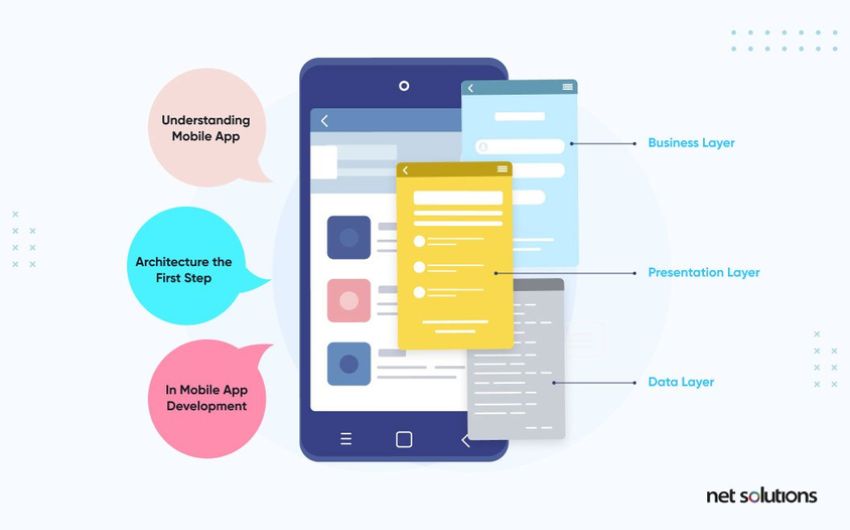
The fundamentals of creating a good app are based on these primary layers of data. Business logic layers: Contains all domain operations and processes. Detailed presentation of the information about the UI. These multi-level architectures define the rules of software development. The dimensions of buildings are individually constructed and integrated seamlessly together. Several technical problems are resolved immediately without disturbing applications during this initial complication. Let us examine this layer.
Presentation Layer
The presentation level for apps is composed of UI processes and UI components. This layer focuses on view and control systems. It is an investigation into how the user presents the app. Developers of mobile apps must determine the appropriate client type to design a layer on an existing application. In addition, the client’s deployment requirements are taken into account. Another condition requires proper data formats and robust validation mechanisms to prevent app entry.
Business Logic Layer
These layers are responsible for all business aspects. The project investigates how the business is displayed to end-users. Because every piece of information will be presented directly to users, everything is perfectly accurate. The layers are composed of various parts such as businesses, workflows, etc. It has two layer-level entities: Domain Models and Services. Service layers explore the definitions of the user-friendly standard app functions set. In contrast, Domain Layers investigates expertise within the domain.
Data Layer
Data access layers must fulfill requirements and help facilitate effective and secure data transactions. Furthermore, developers’ mobile apps must be aware of the maintenance of the data while providing easy modification of the data layer for changes within business needs. The Layer consists of information-related parts like access parts, utilities, and services like help. Three elemental mobile architecture models have been divided into two subgroups: Persistence & Network Layers. Both offer simpler data accessibility stored in the mobile apps backend architecture, and the latter requires network calls.
What are the Key Mobile Application Architecture Principles?
Good app architecture should enforce good programming patterns and assumptions to provide high-quality software used on mobile devices.
Meeting these different conditions allows you to expedite the development process and make maintenance much more manageable. Additionally, a well-designed mobile app design architecture alongside platform-centric technology can solve complicated business issues. This is something that is fundamental for the development of any type of app.
“A mobile app system consists of many components, which should be clarified through the architectural process. Having this overview provides a transparent chain of communication between stakeholders and helps avoid difficult situations later during the development,” mentioned Chintan Shah, CEO, Brainvire.
Choosing your app’s architecture is a tough decision, but following certain principles will help make it easier.
Portability
Portability is the system’s ability to react to the ever-changing environment. In today’s fast-paced, tech-savvy world, mobile apps require constant revisions. Not only that, but the market changes a lot faster than ever before. A good architecture ensures that the system is portable enough to answer the changes, minimizing their impact.
Maintainability
Changing the requirements to match the current needs will help improve performance and correct any faults. Furthermore, as an increasing number of apps become developed and circulate in the market, they need to be updated constantly to meet the growing requirements of their respective industries. Therefore, good mobile architecture and programming must ensure high maintainability while allowing future changes and growth. This can reduce the effort required to keep the system up and to run.
Reusability
A well-designed app architecture should reuse components and protocols during updates to speed up the app development process or redesign. Organizations that want to improve their app development cycle should ensure they can add reusability.
Security
Data security is the most important non-functional need of an application. The app’s architecture must be capable of securing & using any data that is used within it. Your organization needs to have a secure ecosystem in place, and your documents need to be completely encrypted. Furthermore, the AI writer you choose needs to sync with it.
Performance
User experience is one of the most important and valued aspects of product design. If you want your application to succeed, you should make it quick and free from glitches. There are a lot of users who abandon apps because it takes too long for them to download anything. If your app takes longer than 5 seconds to open, the chances of someone abandoning your app increase. Good mobile app architecture should strive to meet the group of users’ unique needs.
This is a vital stage in the process of developing an app. It will be critical to your success and is essential for ensuring that your project stays on schedule.
Let’s see the Example of Mobile App Architecture Usage
A well-defined architecture is important because it will help speed the development process. In addition, developers can control data flow within the application. It makes testing more efficient and enhances quality in applications. The application of each layer of a 3-layer model depends on their purpose. It depends upon screen designs and their behaviors. On another note, the business level depends on how much data is supplied.
Considering Bandwidth Scenarios
Sometimes Internet access is weak or very low. In such a case, everyone needs to consider bandwidth scenarios and local Internet connections when determining population. And a region in which you target the audience. Sometimes the extremely low internet speeds frustrate the app and users might eventually quit the application. A few people find the experience a problem. Therefore, it is advisable to consider the worst possible internet connection while creating the app architecture.
Determining The Device Type
Smartphones are of different types and this should be considered when building an application. Types of smartphones generally depend upon what operating system their devices are running on. As you know, the Android smartphone is different from the iPhone which comes in two distinct classes. It also plays a key determining factor in choosing a mobile application architecture. Another important device-specific characteristic you should take into account is the following:
The important element is the navigational system of apps. To satisfy customers’ needs and wants, it is necessary to choose an effective navigation system. Therefore, using navigation apps in mobile applications is very important. Ideally, a navigation method should be chosen on the App’s website. To find the most appropriate navigational system, follow guidelines to understand the user’s needs better, examining several scenarios.
Stating User Interface (UI)
UI problems often cause app failures. The user must be comfortable using an application that is easily accessible. Therefore, we must be cautious with our approach. Please ensure that you don’t waste the entire time on the interface of the application. Remember the thumb rule, the only tool that helps create highly interactive UIs.
What kind of Problems can Occur While Ignoring Mobile App Architecture?
It is essential to choose mobile application architectures. It is also a critical element in the design and development phases. Unfortunately, developers’ neglect, rushes, and inexperience often ignore the architectural concept. Developing applications without architecture is like building without foundation. Generally, inexperienced developers enjoy faster processing without architecture. Initially, it appears fast but quickly turns out the way out.
Decoding Mobile App Architecture Diagram
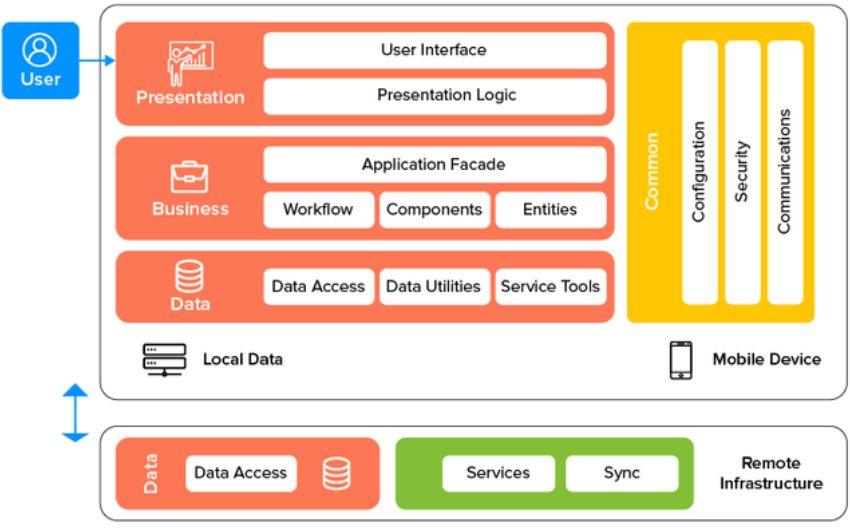
A detailed list of the tools and processes that are required to build a mobile app. In addition, because it’s independent, it maintains efficiency regardless of mobile platforms. We can view mobile apps architecturally in three main categories despite modern technology. App architecture for mobile phones and tablets. App architecture. Enterprise application architecture.
Designing Android App Architecture
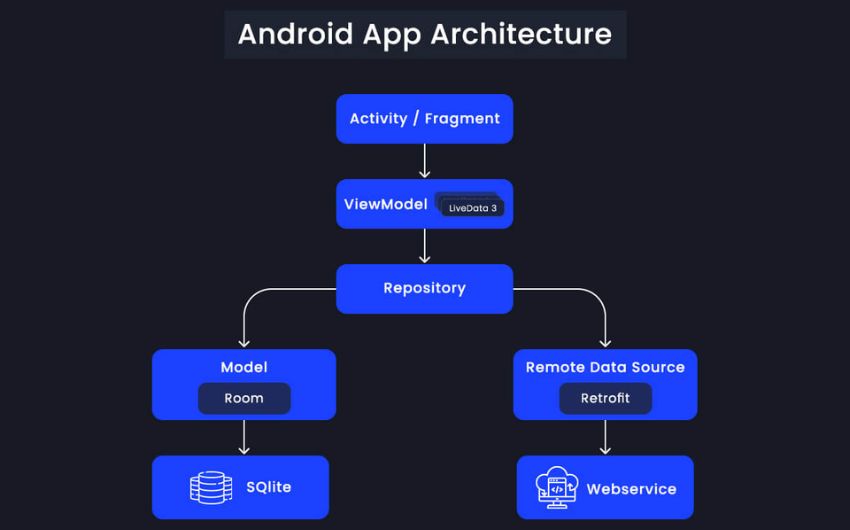
The new guidelines outline various important concepts which should help an Android app develop successfully and safely. An Android application should have clear objectives to differentiate it and drive the user interface from model to model. For example, code that does not interact or operate with the user interface should not be included in activities or fragments. The system is also fully responsible for preventing the destruction or the removal of the Activity or the fragmentation of the Activity.
Designing iOS App Architecture
The iOS apps are divided into four parts:
Core services: Core services provide a centralized database with file management tools.
Interface level: Cocoa touches are given a different name for that interface. It has various components that are used in creating multiple interfaces. In addition, cocoa touches provide information about layers created by the user.
Core OS: CoreOS can also be called kernel OS. This level is directly connected to the file system and monitors the validity of the application certificate.
Kernel levels control the security across systems.
Designing Enterprise App Architecture
Enhanced Mobile Application allows for a smoother interaction between customers and employees. Therefore, it is unavoidable that we need a robust enterprise mobile application design. To create good mobile apps the company has to balance its IT and business needs. This balance helps you keep pace with rapid changes in your business. There is no problem relating to general performance issues or maintenance issues in this sense. In the modern age, mobile apps are essential to an efficient business.
Why is it important to pay close attention to Mobile App Infrastructure?
Selecting the appropriate architecture is the main component of the design phase for a software development project. Generally, however, stages are ignored because they slow down or make a project more complex. However, the failures of mobile app developers are often ironic.
Your architecture plays a significant role if you’re looking to launch a successful mobile app. So it’s imperative to consider which features you want in your app, how you will deploy them and how they are connected in the architectural layers.
The type of architecture for your app depends on many things, such as the type of platform being used to run it and your company’s resources. If app development sounds complicated, it’s best to entrust this part of your project to the experts. These professionals will identify which architecture you should use and help with the process from start to finish.
Related Articles
-
Why Phonegap Mobile App Development Is Important?
What is PhoneGap? Talking About Why Phonegap Mobile App Development Is Important? PhoneGap is an open source hybrid mobile application development framework manufactured by Nitobi (which was then later taken
-
Mobile App – A Necessity for all Businesses!
Businesses have realized the importance of one of the best weapons to boost up revenue, smart phones and that too with the magic of the technology of apps in it.
-
Know The Importance Of Wireframe In Mobile App Development
Talking About Know The Importance Of Wireframe In Mobile App Development, Do you have a mobile app idea? Wanted to shape the idea into a fully-fledged mobility solution? If yes,


